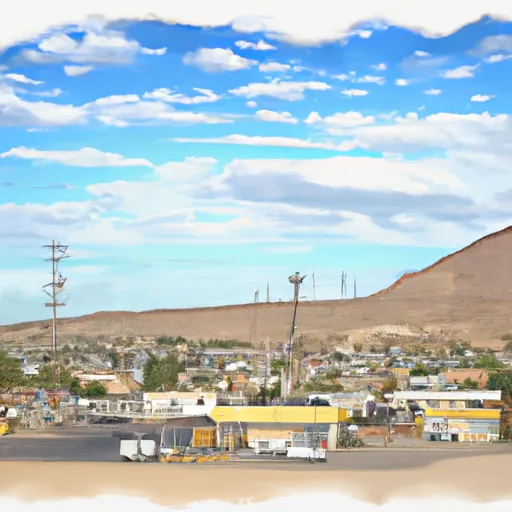-
 Snoflo Premium
Snoflo Premium
Get unlimited access to all our content
With no Ad interruptions! - Start Your Free Trial Login with existing account
Tecopa
Eden Index
Climate
7.8
•
Recreation
4.6
•
Community
0.9
•
Safeguard
5.0/10

Tecopa is a small unincorporated community located in the Mojave Desert, in Inyo County, California. It is situated near the southeastern edge of Death Valley National Park, making it a popular destination for outdoor enthusiasts.
Tecopa experiences a hot desert climate, characterized by extremely high temperatures in summer and mild winters. Summer temperatures often exceed 100°F (38°C), while winter temperatures range between 40°F (4°C) and 70°F (21°C). Rainfall in the area is minimal, averaging less than 2 inches annually.
The hydrology constituents in Tecopa are primarily focused on the Tecopa Hot Springs, known for their therapeutic mineral water. These natural springs attract visitors seeking relaxation and healing. The water contains high levels of minerals such as calcium, magnesium, and sulfur, providing potential health benefits to those who soak in it.
Outdoor recreation opportunities in Tecopa include exploring the nearby Death Valley National Park, known for its stunning landscapes, sand dunes, and unique geological formations like Badwater Basin and Zabriskie Point. Other activities include hiking, wildlife observation, birdwatching, and off-road adventures. Tecopa also offers opportunities for stargazing due to its remote location away from light pollution. Overall, Tecopa provides a serene desert environment with various outdoor activities for nature enthusiasts.
What is the Eden Index?
The Snoflo Eden Index serves as a comprehensive rating system for regions, evaluating their desirability through a holistic assessment of climate health, outdoor recreation opportunities, and natural disaster risk, acknowledging the profound impact of these factors on livability and well-being.
Climate Health Indicator (CHI): 7.8
Tecopa receives approximately
124mm of rain per year,
with humidity levels near 36%
and air temperatures averaging around
21°C.
Tecopa has a plant hardyness factor of
9, meaning
plants and agriculture in this region tend to thrive here all year round.
By considering the ideal temperature range, reliable water supplies, clean air, and stable seasonal rain or snowpacks, the Climate Health Indicator (CHI) underscores the significance of a healthy climate as the foundation for quality living.
A healthy climate is paramount for ensuring a high quality of life and livability in a region, fostering both physical well-being and environmental harmony. This can be characterized by ideal temperatures, reliable access to water supplies, clean air, and consistent seasonal rain or snowpacks.
Weather Forecast
Streamflow Conditions
Northern Mojave
Area Rivers
Northern Mojave
Snowpack Depths
Northern Mojave
Reservoir Storage Capacity
Northern Mojave
Groundwater Levels
Recreational Opportunity Index (ROI): 4.6
The Recreational Opportunity Index (ROI) recognizes the value of outdoor recreational options, such as parks, hiking trails, camping sites, and fishing spots, while acknowledging that climate plays a pivotal role in ensuring the comfort and consistency of these experiences.
Access to outdoor recreational opportunities, encompassing activities such as parks, hiking, camping, and fishing, is crucial for overall well-being, and the climate plays a pivotal role in enabling and enhancing these experiences, ensuring that individuals can engage in nature-based activities comfortably and consistently.
Camping Areas
| Campground | Campsites | Reservations | Toilets | Showers | Elevation |
|---|---|---|---|---|---|
| Shoshone Dispersed - Tecopa | None | 1,691 ft | |||
| Tecopa Hot Springs Park | 250 | 1,390 ft |
Catastrophe Safeguard Index (CSI):
The Catastrophe Safeguard Index (CSI) recognizes that natural disaster risk, encompassing floods, fires, hurricanes, and tornadoes, can drastically affect safety and the overall appeal of an area.
The level of natural disaster risk in a region significantly affects safety and the overall livability, with climate change amplifying these risks by potentially increasing the frequency and intensity of events like floods, fires, hurricanes, and tornadoes, thereby posing substantial challenges to community resilience and well-being.
Community Resilience Indicator (CRI): 0.9
The Community Resilience Indicator (CRI) recognizes that education, healthcare, and socioeconomics are crucial to the well-being of a region. The CRI acknowledges the profound impact of these elements on residents' overall quality of life. By evaluating educational resources, healthcare accessibility, and economic inclusivity, the index captures the essential aspects that contribute to a thriving community, fostering resident satisfaction, equity, and social cohesion.

